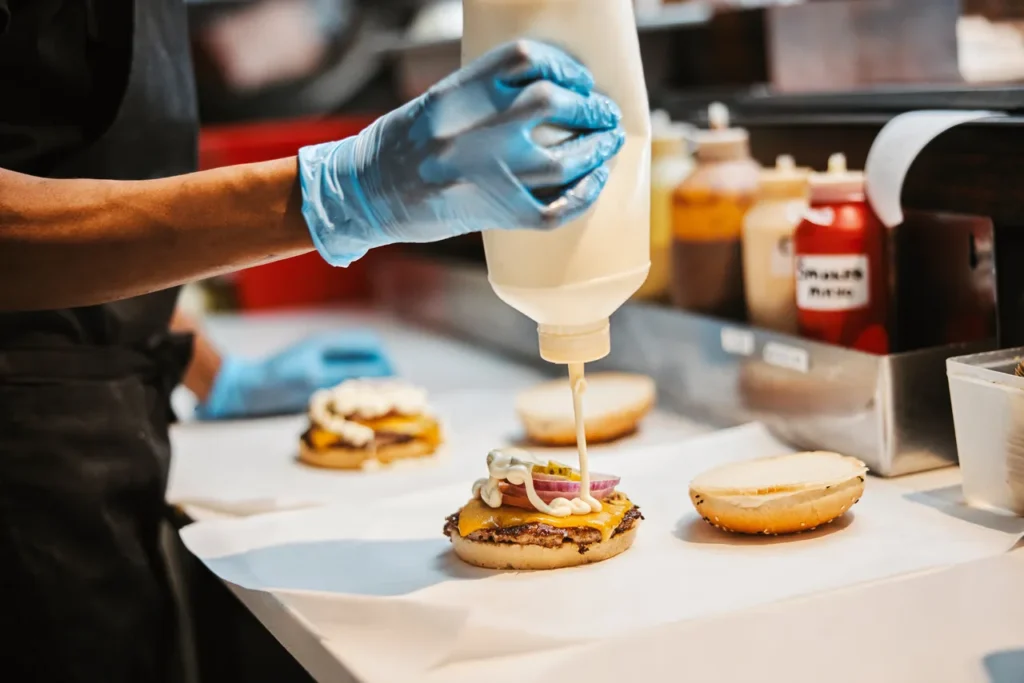The truth behind mayo labels
Non-standardized claims impede the optimization of this ubiquitous foodservice ingredient.
13 August 2025
Share this exclusive content from Saladplate

Photo Credit: Wilsey by Ventura Foods
Mayonnaise is a versatile workhorse in kitchens across cuisines and foodservice segments, but operators might be missing out on its full potential.
The sheer ubiquity of mayonnaise illustrates its importance in foodservice applications: Datassential reports that mayonnaise appears on 47% of all menus, and operators buy 485 million pounds of mayonnaise annually, according to data from Circana.
From simple sandwich spreads to dressings, hot and cold dips, and salads, mayonnaise performs a variety of functions in the kitchen. Despite its perceived versatility, however, the ingredient remains shrouded by a veil of descriptors that don’t always accurately describe its true properties.
Terms such as heavy duty, deluxe, and premium are often used to identify different types of mayonnaise, but these terms lack standardization and are not clearly defined or differentiated. As a result, operators might be using a type of mayonnaise that is not best suited for each of the applications that incorporate the ingredient.
Category leader Ventura Foods commissioned a study with chefs from CIA Consulting, a division of the Culinary Institute of America to understand how different brands of mayonnaise perform in different recipe applications. The test sets the stage for a revolutionary new way of thinking about mayonnaise, proposed by Ventura Foods.
Putting ‘heavy duty’ to the test
Mayonnaise can be made in a variety of ways employing different ingredients, but it generally contains an emulsion of egg yolks, oil, and either lemon juice or vinegar, often combined with additional seasonings. It can have a range of colors, flavors, textures, and properties. The term “heavy duty” generally describes a mayonnaise made with a higher proportion of egg, which is intended to give it a creamier, more stable quality. This is the mayonnaise generally used in commercial foodservice applications.
The lack of a standardized definition, however, might be leading to a “one-size-fits-all” approach to the use of heavy duty mayonnaise in restaurant kitchens. Chefs might, in fact, be using a mayonnaise that is over-engineered for the application in which it is used.
In order to determine how different mayonnaise formulations impact a range of recipe applications, Ventura Foods approached CIA Consulting, which performed the study as an industry service to Ventura. Three of the school’s chefs each prepared three recipes, using four different foodservice brands of mayonnaise, all labelled “heavy duty.”
The chefs, who were not told of the reason behind the test nor the brands that were used, then evaluated the preparations based on several characteristics, including ease of mixing, fluidity, and the texture/viscosity of the final products. The recipes were for a creamy coleslaw, a jumbo lump crabcake, and an artichoke and spinach dip.
The finished recipes demonstrated considerable variations in taste, viscosity, and texture. For example, one mayonnaise variety yielded a clear favorite when it came to making the jumbo crab cakes, with a fuller flavor and better mouthfeel than the other three mayonnaise samples tested, but that same mayonnaise did not work as well as a warm dip. The result was “almost too tight to be a dip,” one of the chefs said.
Creating a solution
The tests proved the hypothesis that not all mayonnaise labelled heavy duty are the same.
The final report noted, “Substituting one mayonnaise for another, if you have a signature dish that requires mayonnaise, would not garner the same results.”
It continued “… either way, chefs and restaurants do not want inconsistencies that can cause issues with their customers that will detract from their meal experience.”
Operators need to understand the best ways to utilize every ingredient in their kitchen in order to provide the best possible experience for their guests. That is why Ventura Foods is rethinking the mayonnaise category and introducing the MayoNeeds framework, an innovative approach in which new descriptors accurately reflect the different attributes of a range of mayonnaise formulations. This will make easy for operators to select the mayonnaise they need to optimize each of their recipe applications.
From sandwich spreads to hot and cold salads and dips, the MayoNeeds framework solution from Ventura Foods will ensure that operators will always use the right mayonnaise for the job.

Source: Nation’s Restaurant News



